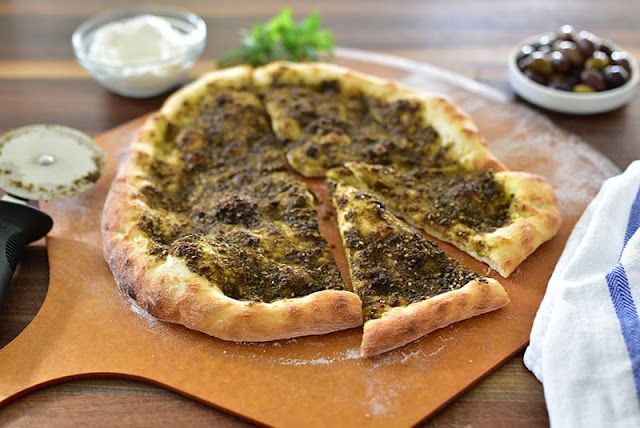ZA'ATAR FLATBREAD RECIPE
RECIPE BY: MAUREEN ABOOD
This recipe is adapted from Chris Bianco’s, published in Eater for focaccia-style bread from his book Bianco: Pizza, Pasta, and Other Foods I Like (Ecco 2017). Take care not to refrigerate the dough much beyond 8 hours or it will over-proof (yes, I've done it). If needed, freeze briefly and then refrigerate to extend proof time. It’s ideal to bring the dough to room temperature before shaping, but I’ve jumped the gun and worked with cool dough and it was equally pliable and glorious as room temp. You’ll need a sheet pan and a pizza peel and long kitchen tongs. You could also use another sheet pan, overturned, as your peel but it’s not nearly as easy or fun. I use a stand mixer too; you can of course knead by hand. The rice flour is perfect for coating the peel and doesn’t get cakey like wheat flour can here. Don’t be alarmed by all of the instructions below! Just read through them before it’s go time to get a feel for each step. Makes 4 flatbreads that cut into 6-8 slices each.
INGREDIENTS
1 envelope active dry yeast (2¼ teaspoons)
2 cups warm water (105° to 110°F; I’ve been taking the water’s temp and it comes out perfectly)
5 cups bread flour, plus more as needed and for dusting
2 teaspoons fine sea salt
3 tablespoons za'atar
3 tablespoons extra virgin olive oil, plus more for greasing the bowl
Rice flour, for coating the pizza peel or back of a sheet pan
INSTRUCTIONS
Combine the yeast and warm water in a large bowl or the bowl of a stand mixer, stirring well and allowing the yeast to become creamy and slightly bubbly (about 10 minutes).
When the yeast has dissolved, add 3 cups of the bread flour, using the paddle attachment on low speed or a wooden spoon and mixing until smooth. Slowly add the last 2 cups of flour, working it in gently on low speed or by hand. Add the salt (Bianco says it’s important to wait until now, so the yeast isn’t inhibited). Mix until the dough comes away from the bowl but is still sticky; if necessary, add up to ½ cup more flour 1 tablespoon at a time (I've never needed to add more myself).
Continue to knead the dough on medium speed or by hand until it is smooth, stretchy, soft, and still tacky.
Brush a large bowl with olive oil (if it's not too doughy, I use the same bowl I mixed the dough in), shape the dough into a ball and turn it over in the bowl to coat with oil. Cover the bowl with plastic wrap and let the dough rest in a warm place until it doubles in size, 2 to 2½ hours.
Turn the dough out onto a floured work surface and cut it into 4 equal pieces. Roll the pieces into balls, stretching the surface of the balls tightly, and dust them lightly with flour. Cover with plastic wrap and let them rest for another hour, or until they have doubled in size.
The dough balls can now be wrapped individually in plastic and refrigerated for up to 8 hours, or frozen for up to a month. Thaw the dough in the refrigerator, then let it come to room temperature before shaping.
When you’re ready to bake the za’atar bread, position an oven rack at the lowest point in the oven with no other racks above it. Or, remove the racks. Place an overturned sheet pan on the rack or base of the oven. Heat the oven as hot as it will go, about 550 degrees F.
In a small bowl, stir the za’atar and olive oil so that you have a wet mixture. Add more oil or za’atar as needed to keep it wet, and depending on how much you like on your flatbread.
Liberally dust the pizza peel with rice flour.
To shape the dough, hold the top edge of the ball with both hands, allowing the bottom edge to hang down with gravity. Carefully move your hands around the edges to form a circle of dough, like turning a steering wheel.
Continue to carefully shape the dough as it relaxes, without letting any area get too thin. Cup your hands and use the backs of your hands, knuckles up, to encourage the dough wider. Don’t stretch or pull too much, or the dough will get too thin or tear.
Lay the circle of dough on the pizza peel that’s been dusted with rice flour. Dab the top of the dough with za’atar and oil, then use your fingertips to stain the surface of the dough with the za’atar and oil. You can use more or less za’atar and oil here; it’s up to you how thickly you spread it on.
Shake the peel to be sure the dough will move off easily. If any area is stuck, lift the dough and dust more rice flour underneath it.
Transfer the dough from the peel to the hot overturned sheet pan in the oven. Turn on the light so you can watch the show! The flatbread will bubble and the edges will “leopard” like the finest pizza in the land. Use tongs to turn the flatbread as it bakes to avoid any spot getting burned.
When the flatbread is golden brown (about 4 minutes), use the tongs to pull the flatbread back onto the peel and remove it from the oven.
Let the bread rest for a few minutes, then cut it with a round pizza cutter.
Repeat this process with the remaining dough balls.
Congratulations!








Nice Post! I am really impressed with your efforts and really pleased to visit this post.
ReplyDelete